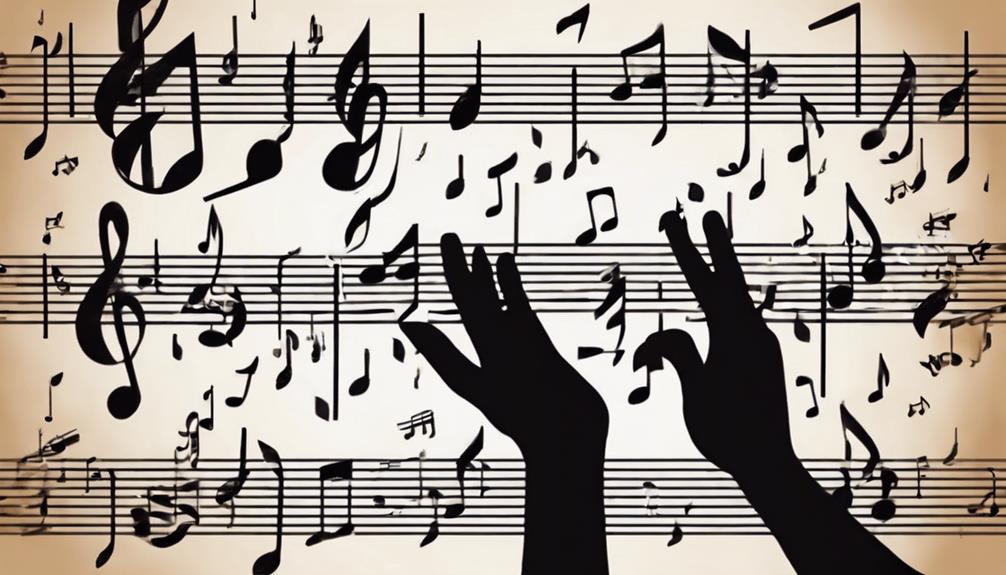No products in the cart.
First, get familiar with the basics of the 9/8 time signature. Imagine each measure divided into three beats, counted as ‘one and uh, two and uh, three and uh’ with each beat split into three parts. Next, incorporate a metronome into your practice. Start at a slow pace and sync your counting to its ticks, ensuring precise timing. Finally, gradually increase the metronome’s speed to challenge and enhance your counting and rhythm. With patience and practice, you’ll develop a solid feel for playing in 9/8, allowing for more nuanced musical expression. Stick with these steps, and you’ll realize the rhythm’s full potential.
Contents
hide
Key Takeaways
- Start by dividing each measure into three beats, counting as ‘one and uh, two and uh, three and uh’.
- Use a metronome set to a slow tempo to practice counting in 9/8, gradually increasing speed as confidence grows.
- Focus on maintaining a steady pace, ensuring each ‘and uh’ is evenly spaced within the beats.
- Practice transitioning smoothly between measures to maintain the flow of the 9/8 rhythm without breaks.
- Incorporate complex pieces with tempo and dynamic changes to apply counting skills in varied musical contexts.
Understanding 9/8 Rhythm Basics
Why should you learn about 9/8 rhythm basics? Mastering the 9/8 time signature is essential for enhancing your beat division and rhythmic accuracy. This time signature, characterized by 9 beats in each measure with an eighth note receiving one beat, demands a unique approach to counting. You’ll count it as ‘one and uh, two and uh, three and uh,’ dividing each beat into three parts. This subdivision is your first step towards achieving a solid understanding of how rhythms work in more complex time signatures.
Understanding how to count in 9/8 isn’t just about keeping time; it’s about enriching your musical expression. Phrasing and musical interpretation heavily rely on how well you can navigate through these beats. By practicing the counting pattern of 9/8, you’re not only working on your ability to maintain a steady tempo but also on how to convey the emotional and rhythmic nuances of the music. This knowledge will open up new dimensions in your playing or singing, allowing for more expressive and dynamic performances.
Utilizing a Metronome
After mastering the basics of counting in 9/8 rhythm, it’s time to bring a metronome into your practice to sharpen your timing and rhythmic accuracy. Setting the metronome to the appropriate tempo for 9/8 time signature is your first step. This foundational metronome technique ensures you maintain a steady rhythm, important for mastering this complex time signature.
As you begin, focus on syncing your counting with the metronome clicks. This timing exercise is essential; it trains your ear to recognize the beat and your mind to maintain the pattern without drifting. Each click should align with your count, reinforcing your internal metronome.
The challenge doesn’t stop with just keeping the pace. Practice smoothly shifting between measures while keeping pace with the metronome. This step is significant as it prepares you for more complex pieces where tempo and dynamics can change.
Gradually Increasing Tempo
Once you’ve built a solid foundation at a slow tempo, it’s essential to gradually increase the speed to challenge and enhance your counting skills in 9/8 time signature. Starting slow has given you the accuracy and clarity needed, but now it’s time to face tempo challenges head-on. A metronome will be your best ally in this phase, allowing you to methodically push your boundaries.
Begin by slightly increasing the metronome’s tempo from your comfortable starting point. It’s not just about counting faster; it’s about maintaining the precision of your counting as the speed increases. This incremental approach helps you adapt without overwhelming yourself. As you become more confident at each new tempo, nudge the pace up again.
Pay close attention to smooth changes between measures. The goal is to make sure your counting remains seamless, even as you pick up the pace. This focus will prevent any disruption in the flow of your rhythm, making your performance feel and sound more natural.
Consistent practice at these varied tempos won’t only boost your confidence but will greatly improve your proficiency in mastering the 9/8 time signature. Remember, each step up in tempo is a step forward in your musical journey.
Frequently Asked Questions
How Do You Count in 9 8 Time Signature?
To count in 9/8 time signature, think of it as a compound meter. Group beats into ‘one and a, two and a, three and a.’ This rhythmic grouping strategy helps you keep the rhythm easily.
How Do You Teach a Simple Time Signature?
To teach a simple time signature, start with rhythm games and clapping exercises. They’ll help you grasp the basics quickly. Remember, it’s all about feeling the beat and keeping a consistent pace.
How Do You Count Notes in 3 8 Time?
To count notes in 3/8 time, you’ll focus on compound meter basics. Divide the measure into three beats, using “one, two, three.” Apply rhythmic grouping strategies for precision, emphasizing the first beat for flow.
How Do You Count Every Time Signature?
To count any time signature, you’ll master odd meter basics and practice clapping rhythms. Start slow, break down beats, and gradually speed up. Consistency’s key, so keep at it and you’ll ace every measure!
Conclusion
Now that you’ve got a handle on the 9/8 rhythm basics and utilized a metronome to keep your pace, you’re well on your way.
Remember, it’s all about taking it slow at first. Start with a tempo that feels comfortable, letting you truly feel each beat and subdivision.
Then, gradually ramp up the speed as you get more confident. Stick with it, practice consistently, and you’ll be counting and playing in 9/8 like a pro in no time.
Keep pushing yourself!




